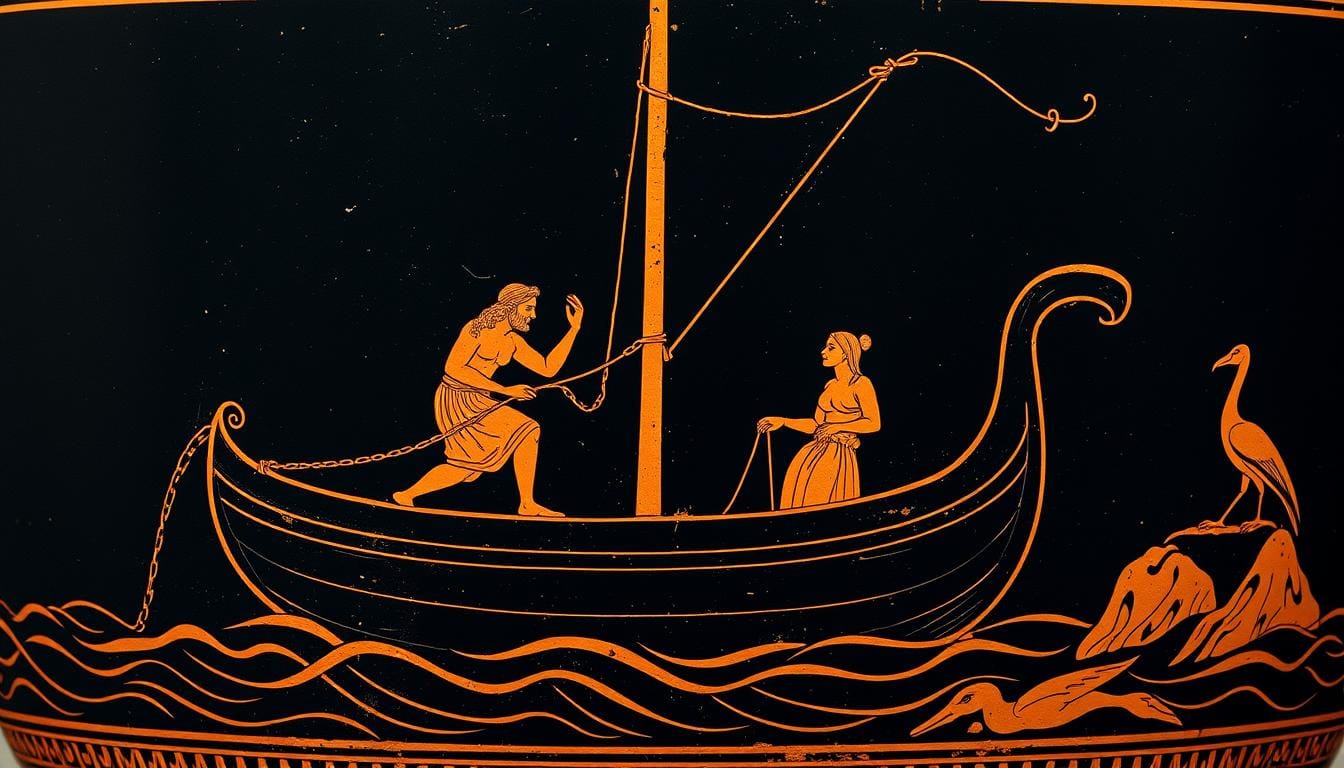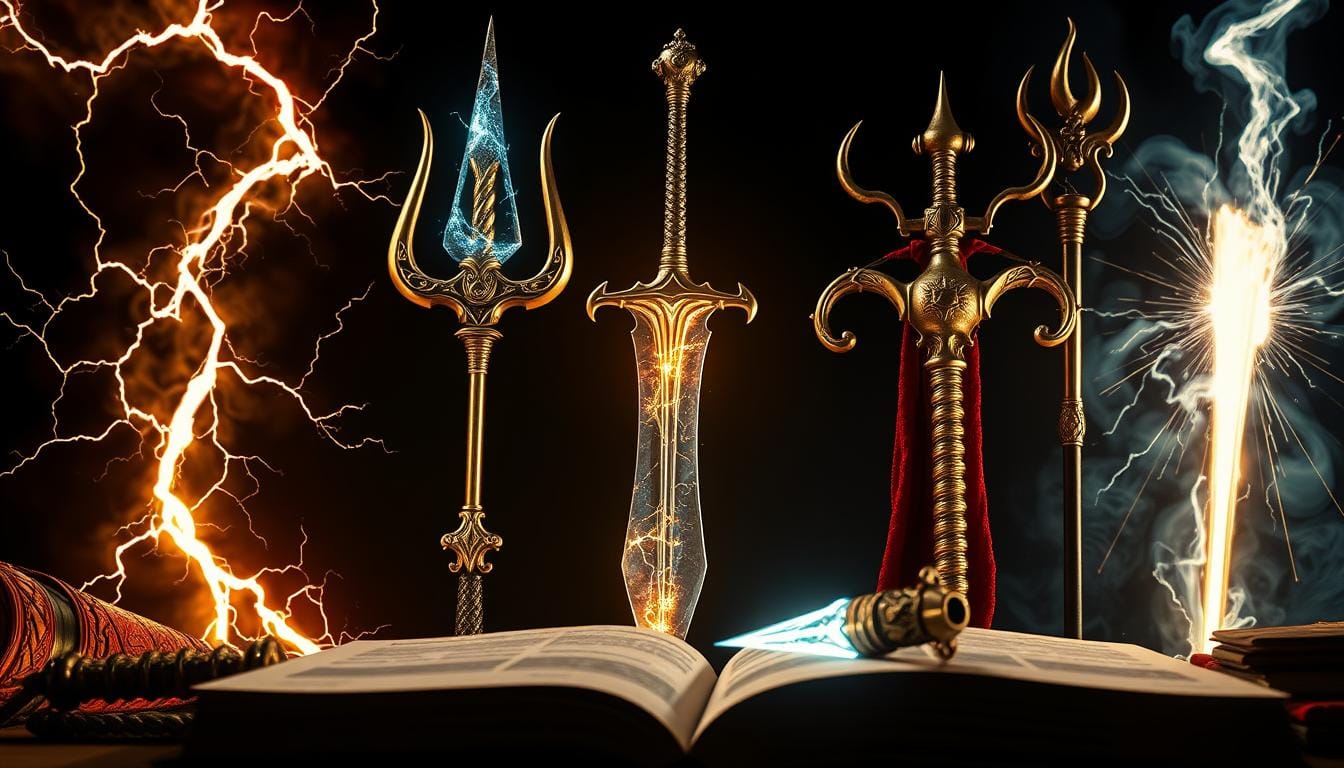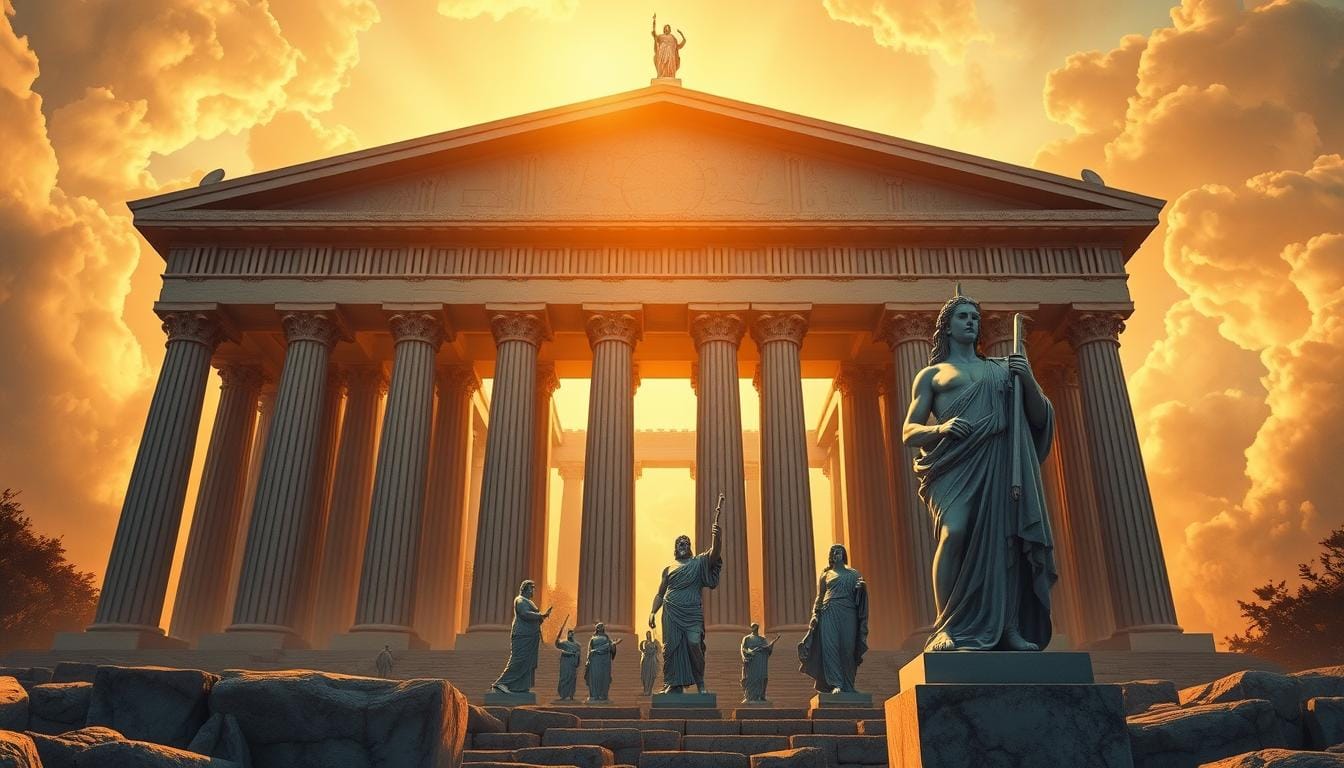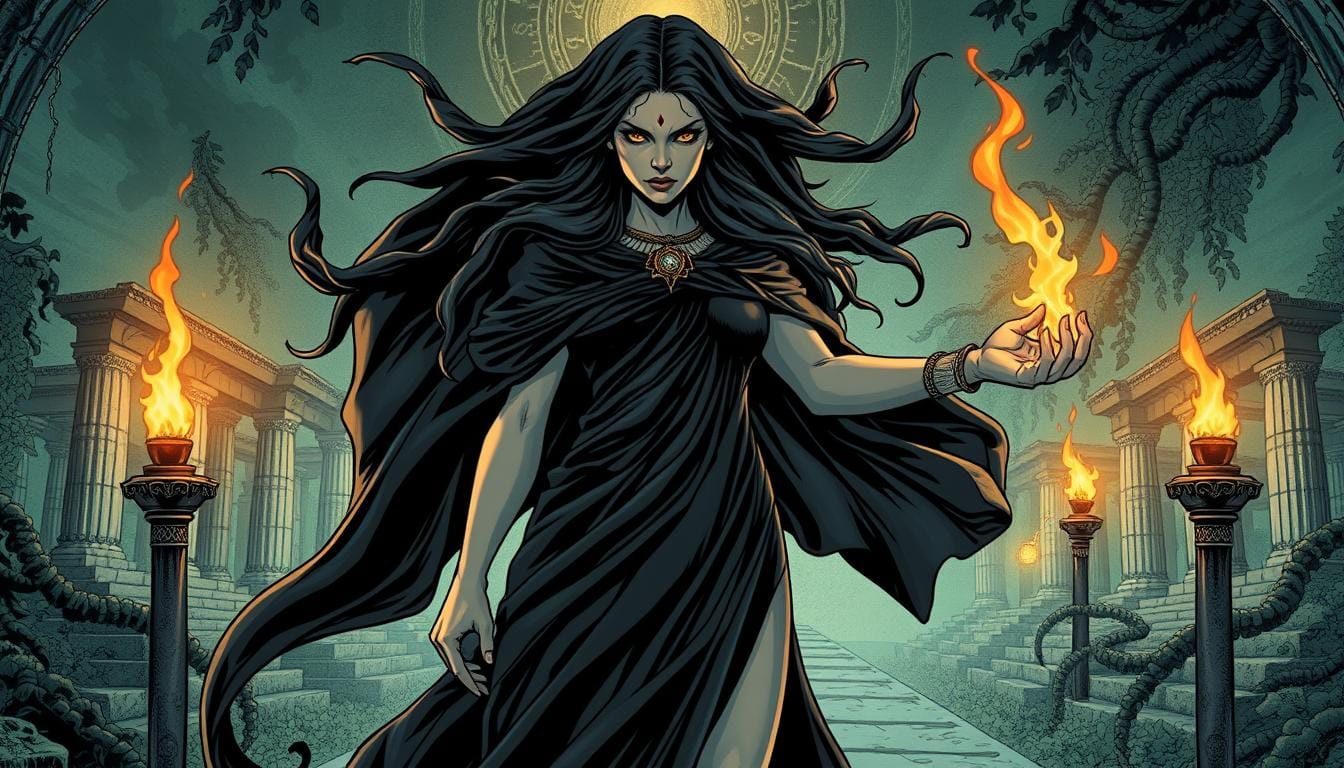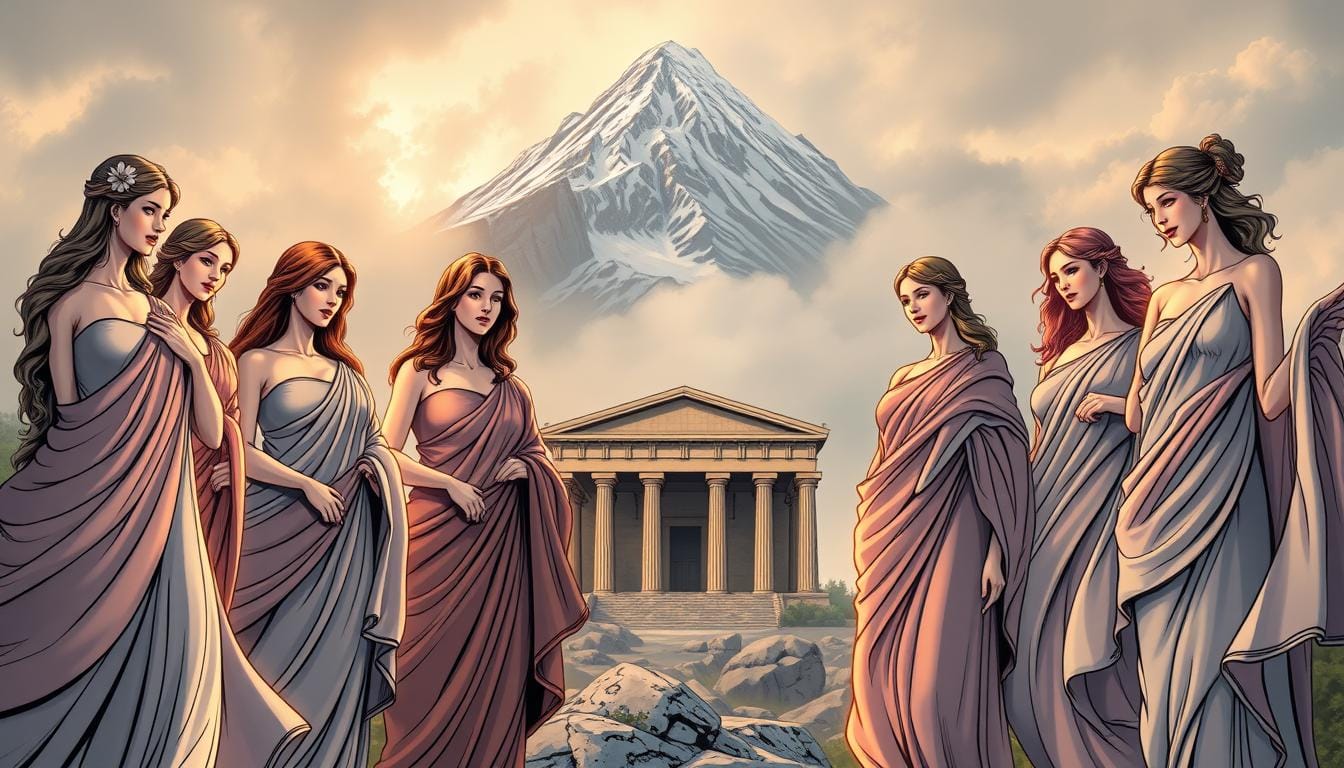Over 2.5 million copies of Jean Shinoda Bolen’s book “Goddesses in Everywoman” have been sold worldwide. This shows how much people love ancient goddess stories. These stories are more than just old tales.
Carl Jung’s work shows that these goddess patterns are in our minds. They shape who we are, what we choose, and how we grow. These powerful forces wait to be found in every woman’s mind.
Today, psychology sees these goddesses as deep guides for living. Each one brings special wisdom for facing today’s problems. From Athena’s smart thinking to Aphrodite’s deep feelings, they show us how to live truly.
Knowing these archetypes helps women see their full selves. They show ways to find oneself, grow, and truly be free across all cultures and times.
Key Takeaways
- Ancient goddess patterns represent deep psychological blueprints that influence modern women’s lives
- Jean Shinoda Bolen’s research connects mythological figures to contemporary personal development
- Carl Jung’s archetypal psychology explains how these patterns reside in our collective unconscious
- Each goddess archetype offers unique wisdom for navigating life’s challenges and opportunities
- Understanding these patterns empowers authentic self-expression and personal transformation
- These timeless energies transcend cultural and historical boundaries, remaining relevant today
1. Introduction to Female Archetypes in Greek Mythology
The legendary women of Greek mythology are more than just stories. They show timeless patterns of behaviour and experience that touch our deepest psychological truths. These Greek goddesses and heroines have captivated us for thousands of years. They reflect fundamental aspects of human nature that are just as relevant today.
Looking at these ancient stories through a modern lens, we see that mythological women are powerful archetypes. They show universal themes like love, wisdom, motherhood, independence, and transformation. These themes cross cultural boundaries and historical periods.
Carl Jung’s work shows why these characters are so deeply resonant today. Jung said archetypes are deep patterns in culture that inspire and empower us. They appear in myths and stories as the basic structure of human psychology.
Definition of Archetypes
Archetypes are universal patterns of behaviour and experience in humanity’s collective unconscious. They appear across cultures and time, showing something fundamental about human nature.
Jung called archetypes primordial images that shape our world and ourselves. When we meet these patterns in myths, they trigger deep recognition. This is why certain characters and stories feel instantly familiar, even when we first see them.
The power of archetypes lies in their ability to awaken energy, passion, truth, and personal power in us. Greek goddesses like Athena, Aphrodite, and Artemis embody distinct archetypal energies. These are energies we can recognise and connect with in our own lives.
| Archetypal Pattern | Psychological Function | Cultural Expression | Personal Impact |
|---|---|---|---|
| The Wise Woman | Guidance and knowledge | Athena’s wisdom | Strategic thinking |
| The Lover | Connection and beauty | Aphrodite’s allure | Emotional expression |
| The Mother | Nurturing and protection | Demeter’s care | Compassionate strength |
| The Independent | Self-reliance and freedom | Artemis’s autonomy | Personal boundaries |
Importance in Mythology
Greek mythology is a rich source of archetypal wisdom. It presents complex, multifaceted female characters who show both light and shadow of human nature. Unlike simple fairy tale figures, these mythological women show the full range of human emotions and experiences.
The importance of these archetypes goes beyond academic study. They offer practical tools for personal growth and self-understanding. When we see archetypal patterns in ourselves, we tap into deeper sources of motivation and meaning.
Also, Greek mythology’s lasting impact on Western culture means these archetypes continue to shape modern literature, film, and art. Understanding these foundational patterns helps us uncover the deeper meanings in modern stories and cultural expressions.
The psychological relevance of these ancient figures shows that human nature has universal elements that go beyond historical context. Greek goddesses remain compelling because they represent aspects of the feminine experience that are as relevant today as they were in ancient times.
2. The Role of Women in Greek Society
The female characters in ancient Greece’s mythology were truly remarkable. They stood out against a society dominated by men. These goddesses and heroines showed ideals and freedoms that real women could only dream of.
The gap between myth and reality was huge. Goddesses like Athena had power and authority, but real women faced strict limits. This contrast made for compelling stories about power, wisdom, and strength.
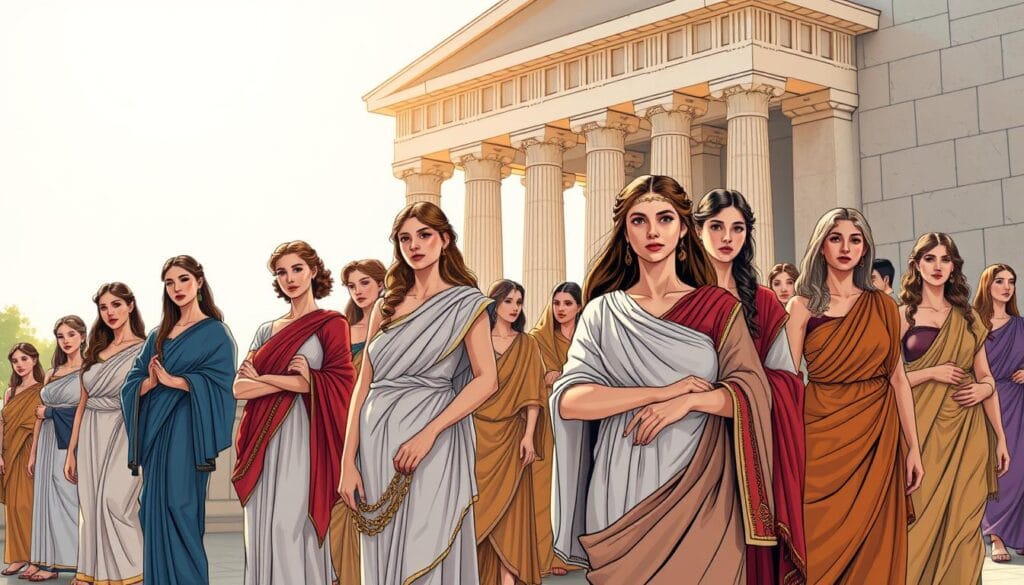
Historical Context
In ancient Greece, men ruled everything. They controlled politics, war, and society. Women were kept out of public life and decision-making.
Philosopher Xenophon believed that god made women for indoor work and men for outdoor work. This view supported the existing social order and kept women at home.
Even though Greek city-states differed, women were never equal. Spartan women had a bit more freedom than Athenian women. But even in Sparta, women were under male control.
The myths showed a world where women had powers they could only dream of. These stories were both a way to escape and a commentary on society.
Expectations and Limitations
Greek society had strict rules for women. Marriage and motherhood were their main roles. Women were expected to manage homes well but stay out of public view.
Women had no say in politics. They couldn’t vote, hold office, or speak in public. They had few legal rights, with men controlling their property and life choices.
Education was hard for women to get. Some rich families taught them to read, but schools were mainly for boys. This made women dependent on men for learning and culture.
Women had a small role in religious festivals. Priestesses were respected in some cults, but their power was limited. Even in religious settings, women’s authority was checked by men.
3. The Goddess Athena: Wisdom and Warfare
Athena was born fully grown from Zeus’s head, wearing golden armour. Her birth story is unique in Greek mythology. It shows her as a complete warrior, ready for battle.
Her story tells of combining feminine wisdom with masculine power. Zeus trusted her completely with his symbols of power.
Athena is the goddess of logic and self-assurance. She navigates patriarchal structures with skill. Her intellect guides her, showing strategic thinking as a feminine strength.
Today, Athena’s spirit lives in women who excel in male-dominated fields. They use their intellect and practical skills to succeed.
Sacred Symbols and Divine Attributes
Athena’s golden armour is her most famous symbol. It shows her protection and readiness for battle. Unlike Ares, she fights with strategy and defence.
Her breastplate and helmet show feminine power through wisdom, not just strength. The owl, sacred to Athena, symbolises wisdom and vigilance. It sees truth in darkness, just like Athena.
Athena’s spear and shield show her warrior side. The olive tree represents her role in bringing peace and civilisation.
These symbols show Athena’s nurturing and protective sides. Her aegis, with Medusa’s head, turns rage into protection. This shows her ability to use powerful energies wisely.
Mythological Influence and Heroic Patronage
Athena is a patron of heroes and defender of civilisation in Greek mythology. She guided Perseus against Medusa, giving him a shield to reflect Medusa’s gaze. Her advice was key for heroes needing courage and cunning.
In the Trojan War, Athena helped the Greeks win. She inspired the Trojan Horse, showing feminine wisdom can achieve more than force. Her rivalry with Poseidon led to Athens, where she gave the olive tree, symbolising wisdom and prosperity.
Today, Athena’s spirit is seen in leaders like Condoleezza Rice. They combine intellect with strategy, showing Athena’s influence in leadership. They work within power structures while staying true to their feminine strength.
4. The Allure of Aphrodite: Love and Beauty
Aphrodite is a standout among powerful women in Greek legends. She is the goddess of love, beauty, and creativity. Her power goes beyond just love, touching our deepest desires and inspiring art.
The ancient Greeks saw Aphrodite as both revered and feared. She was the force that brought life and the power that could destroy. Her dual nature made her a complex figure in Greek mythology.

The Birth of Aphrodite
Aphrodite’s story shows her unique place among powerful women in Greek legends. She was born from sea foam when Cronus threw Uranus’s genitals into the sea. This story shows love’s power to change and transform.
Her name comes from the Greek word aphros, meaning foam. As she emerged in Cyprus, flowers bloomed. This shows how love can turn chaos into beauty.
Being born from the sea, Aphrodite is connected to creation. Unlike others, her birth was unique, giving her freedom from family ties. This freedom lets her act outside normal rules.
Her Impact on Other Myths
Aphrodite’s influence is seen in many Greek myths. She can start great love stories or cause big conflicts. Her role shows how powerful women in Greek legends could change the lives of gods and mortals. The Trojan War began because of her promise to Paris.
In the myth of Pygmalion, Aphrodite brings Galatea to life. This shows her power over creation. Her story with Adonis shows her deep emotional connection. These tales make her more than just a distant deity.
But Aphrodite also has a darker side. She curses Hippolytus for rejecting her love. Her wrath shows the danger of ignoring love. This shows the ancient Greeks’ view of love as both a blessing and a curse.
| Aspect | Positive Manifestation | Shadow Manifestation | Modern Relevance |
|---|---|---|---|
| Creative Power | Artistic inspiration and beauty | Obsessive perfectionism | Self-expression through art |
| Romantic Love | Deep emotional connections | Destructive passion | Healthy relationship dynamics |
| Sensuality | Appreciation of physical pleasure | Excessive indulgence | Body positivity movement |
| Independence | Freedom from social constraints | Disregard for consequences | Women’s liberation ideals |
Sappho called Aphrodite the “deceitful child of Zeus”. This highlights her complex relationship with truth and desire. It shows ancient Greek worries about independent, sensual women.
Aphrodite’s legacy lives on today. She represents the courage to follow one’s heart, despite what others think. Her story reminds us of love’s power to change us and the world around us. Her place among powerful women in Greek legends shows our ongoing fascination with love’s mysteries.
5. Demeter: The Maternal Guardian
Demeter is a powerful symbol of motherhood, showing how love can change the world. She is one of the most important female figures in Greek myths. Her story highlights the deep bond between a mother and her child, affecting both humans and gods.
Demeter is more than just a mother. She shows the strong protection mothers have for their kids. Her story teaches us about the strength and vulnerability of maternal love.
The Myth of Persephone
The story of Persephone’s abduction is very moving. When Hades took her, Demeter’s sadness made the earth barren. She stopped taking care of the earth, causing crops to wither.
Demeter searched for Persephone for nine days, refusing to eat or drink. Her sadness was so deep that it threatened to destroy all life.
Eventually, a deal was made. Persephone would spend half the year with her mother and half with Hades. This created the seasons. When Persephone is with her mother, winter comes. When she’s with Hades, spring arrives, showing Demeter’s joy.
This myth shows the complex bond between mothers and daughters. It talks about separation, growing up, and the bittersweet nature of change.
Harvest and Fertility Themes
Demeter is also the goddess of agriculture and harvest. She links motherly care to the earth’s fertility. Her story teaches us to care for the earth as we do for our children.
Women who find joy in nurturing roles embody Demeter. This includes mothers, teachers, and healthcare workers. They create abundance through their care.
But Demeter’s story also warns about the need for balance in caring. Her grief almost destroyed the world. It shows that healthy care needs boundaries. The seasonal cycle she created is a natural balance of giving and receiving.
Today, Demeter is seen as a symbol of environmental stewardship and sustainable living. Her connection to the harvest teaches us to care for the earth for the future.
6. Hera: The Queen of the Gods
Hera’s story among Greek goddesses shows how marriage can both lift and limit a woman’s identity. As Zeus’s wife and Queen of Olympus, she had great power but faced constant shame from her husband’s many affairs. Her story teaches us about women who see marriage as their main identity and purpose.
Hera’s character is complex because she always stayed true to marriage. Even when Zeus cheated on her, she remained loyal. This loyalty often turned her into a figure of anger and jealousy.

Marriage and Loyalty
Hera was the top goddess of marriage among Greek goddesses. She watched over weddings and blessed them with her presence. Women in ancient Greece prayed to her for happy marriages and children.
Her loyalty to Zeus, despite his many betrayals, shows both her strength and tragedy. Hera’s anger was directed at Zeus’s lovers and children, not him. This shows the strict rules for married women in ancient Greece.
The goddess believed a woman’s value came from her marriage. Her identity was so tied to being Zeus’s wife that she couldn’t imagine life without it. This was the ultimate sacrifice of personal happiness for social norms.
Hera's Role in Major Myths
Hera’s angry side is seen in many Greek myths, often because of Zeus’s affairs. She turned Io into a cow and sent a gadfly to chase her forever. She also tormented Heracles, Zeus’s son with a mortal, for his whole life.
The story of Leto shows Hera’s power and jealousy. When Leto was pregnant with Zeus’s twins, Hera wouldn’t let any land help her. Leto gave birth to Apollo and Artemis on the island of Delos.
In the Trojan War, Hera was angry with Paris for choosing Aphrodite over her. This led her to support the Greeks. Her anger shows how personal issues can affect big events in Greek myths.
| Myth | Hera’s Action | Motivation | Outcome |
|---|---|---|---|
| Io’s Transformation | Turned Zeus’s lover into a cow | Jealousy over affair | Io wandered the earth in torment |
| Heracles’ Trials | Sent madness and obstacles | Hatred of Zeus’s illegitimate son | Heracles performed twelve labours |
| Leto’s Persecution | Prevented lands from sheltering her | Anger at Zeus’s affair | Apollo and Artemis born on Delos |
| Trojan War | Supported Greeks against Troy | Wounded pride from Paris’s judgement | Troy’s eventual destruction |
Today, Hera is seen as a symbol of women stuck in bad marriages. Her story speaks to those who value commitment over happiness. Yet, her divine status also shows the power of embracing traditional feminine roles.
The Hera archetype continues to shape our views on marriage and loyalty. She teaches us that devotion to a partner can be both a strength and a limit to personal growth.
7. The Tragedy of Medusa: From Beauty to Monstrosity
Few mythological women have captured the imagination like Medusa. Her story is one of power and victimhood. It shows how divine justice can punish the innocent while protecting the guilty.
Medusa’s tale challenges our views on heroism and villainy. It has evolved from an ancient story to a symbol of female strength today. This change shows how our views on women’s experiences of trauma have shifted.
The Transformation of Medusa
Medusa started as a beautiful priestess in Athena’s temple. She had stunning golden hair and captivating eyes. Her beauty was both a gift and a curse.
Tragedy struck when Poseidon, the god of the sea, assaulted her in the temple. Instead of punishing Poseidon, Athena turned her anger on Medusa. This injustice changed Medusa’s hair into snakes and her eyes into deadly weapons.
This transformation was more than just physical. It showed how society often blames victims for crimes. Medusa’s punishment reflected ancient views that blamed women for male violence. Her monstrosity was a manifestation of feminine rage that society feared.
Perseus later hunted Medusa as part of his quest. Even in death, she remained powerful. Her severed head could petrify enemies, becoming a tool for heroes and a symbol on Athena’s shield.
Medusa's Legacy in Culture
Today, Medusa is seen as a symbol of survival and transformation. Artists and writers view her as a victim who found power through her pain. This change shows our growing understanding of trauma and resilience.
The Medusa archetype is found in literature, art, and popular culture. Renaissance artists showed her as both beautiful and terrifying. Modern feminists see her as a symbol of female empowerment. Her image is on everything from ancient coins to modern fashion.
Psychologists see Medusa’s story as a representation of our shadow selves. Her transformation speaks to the impact of trauma on how we see ourselves and others.
| Historical Period | Cultural Interpretation | Symbolic Meaning | Artistic Representation |
|---|---|---|---|
| Ancient Greece | Cautionary tale | Divine punishment | Protective amulets |
| Renaissance | Artistic subject | Beauty and terror | Paintings and sculptures |
| Modern Era | Feminist symbol | Female empowerment | Literature and film |
| Contemporary | Trauma survivor | Resilience and strength | Digital art and fashion |
The ongoing fascination with Medusa shows how mythological women evolve in meaning. Her story resonates with anyone who has faced transformation through adversity. She symbolises finding strength in our darkest moments.
Today, we see Medusa differently than ancient Greeks did. They feared her; we understand her. This change shows our growing empathy for those who have faced injustice. Her legacy teaches us that even in our darkest moments, we remain human.
8. Artemis: The Independent Huntress
Artemis, the silver-bowed huntress, stood out in Greek mythology. She chose freedom over traditional roles. As Apollo’s twin, she protected the wilderness and championed women’s independence.
Her story inspires women today who value freedom and justice. They see her as a symbol of strength and autonomy.
Artemis was a true champion of women’s rights. She roamed the wild with her nymphs, creating a community of respect and purpose. Her legacy encourages women to embrace their wild side.
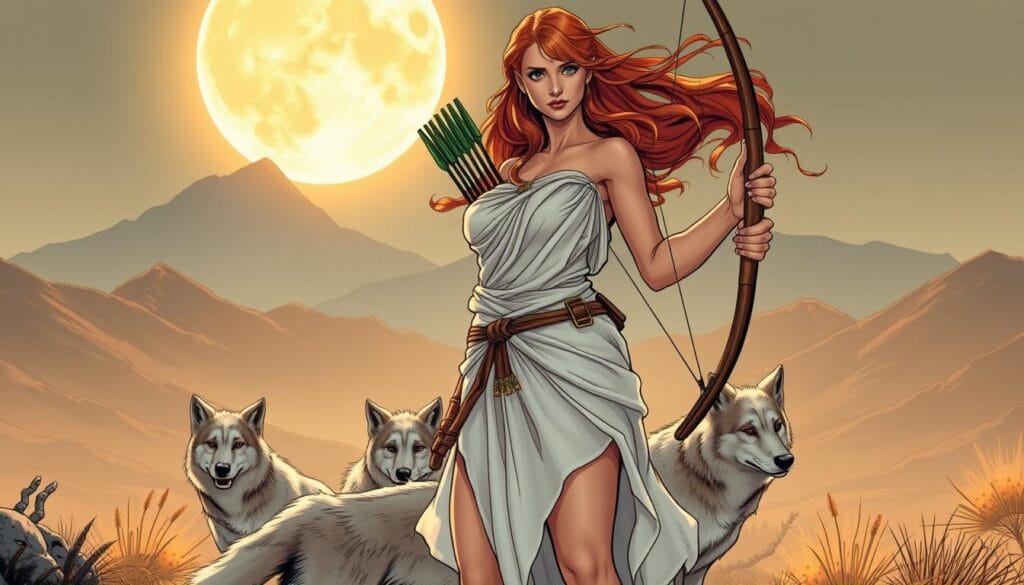
Divine Symbols and Sacred Attributes
Artemis had symbols that showed her love for freedom and nature. Her silver bow was a gift from Zeus, symbolising her divine right to protect. It showed her precision and focus.
Her hunting hounds were symbols of loyalty and friendship. They followed her everywhere, showing the power of true companionship. Artemis’ choice to remain a virgin showed her desire for independence.
The cypress tree and amaranth flower were sacred to her. They stood for eternal life and strength. Wild animals, like deer and bears, saw her as their protector. These symbols highlight her commitment to preservation and nurturing.
Legendary Tales of Protection and Vengeance
Artemis was known for her fierce protection and unwavering principles. As a child, she asked Zeus for eternal virginity and a pack of hounds. This showed her determination from a young age.
Her story of Actaeon shows her justice when boundaries are crossed. She turned him into a stag, leading to his death. This tale highlights her dedication to protecting women’s privacy.
Artemis also defended her mother Leto against Tityos. She used her silver arrows to protect her family. This shows her strength and compassion, proving that independence doesn’t mean being cold.
| Modern Artemis Figures | Field of Influence | Artemis Qualities Displayed | Impact on Society |
|---|---|---|---|
| Gloria Steinem | Feminist Activism | Independence, sisterhood, equality | Women’s rights advancement |
| Julia Butterfly Hill | Environmental Protection | Nature connection, fierce protection | Forest conservation awareness |
| Amy Wambach | Professional Athletics | Competitive spirit, team loyalty | Women’s sports recognition |
| Katniss Everdeen | Literary Character | Archery skills, protective instincts | Youth empowerment inspiration |
Today, women who follow Artemis’ path continue her legacy. They show that strength can be found in fighting for the environment and social justice. These modern huntresses prove that ancient wisdom is as relevant today as it was in the past.
9. Penelope: The Ultimate Faithful Wife
The story of Penelope shows how female characters in ancient Greece could be powerful through patience and smart thinking. Her story is more than just a tale of a waiting wife. It’s about a woman who used her brain to get through tough times. Penelope proves that being loyal doesn’t mean you have to be passive.
Unlike many female characters in ancient Greece, Penelope took charge of her life while seeming to follow rules. Her twenty-year wait for Odysseus was a clever fight against her suitors. She turned waiting into a smart battle plan.
Her Role in the Odyssey
In Homer’s epic, Penelope is Odysseus’s match in brains, using her cleverness to outsmart him. Her famous weaving trick is a great example. She worked on a shroud for Laertes by day, saying she’d choose a suitor when it was done.
At night, she secretly took it apart, buying time and keeping up the illusion. This trick lasted three years before she was found out. Her cleverness shows how female characters in ancient Greece could act within strict rules.
The scene where Penelope meets Odysseus again shows her cautious wisdom. She didn’t just believe the stranger was her husband. She tested him with secrets only Odysseus knew. Her doubt shows her sharp mind and protective nature.
Modern Interpretations of Penelope
Today, scholars see Penelope as a symbol of female strength and not just a devoted wife. They highlight her creativity, smarts, and quiet strength. She stands for women who keep their integrity in tough times.
Feminist views see Penelope’s story as a challenge to old gender roles in female characters in ancient Greece. Her weaving is seen as a symbol of women’s creative power and their ability to change stories. The loom becomes a tool of resistance.
Nowadays, people admire Penelope’s strategic patience as a choice, not just acceptance. Her story inspires modern women who show loyalty while keeping their own power. She shows the balance between commitment and self-care.
Penelope’s story is more than just a tale. It’s a deep look at what true devotion means. It shows the value of emotional depth and practical wisdom. She remains a powerful example of thoughtful waiting, not just endurance.
10. Conclusion: The Enduring Legacy of Female Archetypes
The divine feminine in Greek mythology shapes our view of women today. These ancient stories give us timeless wisdom. They cross cultural and time boundaries.
Influence on Modern Culture
Today’s books, movies, and psychology are filled with these mythological themes. Authors like Margaret Atwood and directors like Patty Jenkins create characters inspired by Athena and Artemis. These stories help us see patterns in ourselves and our growth.
Psychologists use these myths to help people understand themselves better. The divine feminine in Greek mythology offers a wealth of models for self-discovery.
Reflection on Contemporary Feminism
Jean Shinoda Bolen’s work shows how goddess archetypes can lead to true feminism. These archetypes unlock creativity, energy, and joy. They help women find their true selves and life’s purpose.
These archetypes celebrate the complexity of being a woman. They go beyond simple stories to show the full range of women’s abilities. From Penelope’s loyalty to Medusa’s transformation, and from Demeter’s care to Artemis’s boldness.
Grasping these mythological patterns lets us share our unique talents honestly. We draw strength from centuries of storytelling wisdom.
FAQ
What are female archetypes in Greek mythology and why are they important?
Female archetypes in Greek mythology are patterns of feminine energy and behaviour. They are based on Carl Jung’s theories and Jean Shinoda Bolen’s work. These archetypes represent timeless aspects of the feminine psyche, influencing modern women’s lives.
They serve as powerful tools for self-discovery and personal transformation. They help us understand different facets of feminine power and wisdom.
How did the patriarchal structure of ancient Greek society influence these mythological women?
Ancient Greek society was heavily patriarchal, with women confined to domestic spheres. This created a fascinating contrast in mythology. Goddess figures possessed immense power, unlike real women.
The mythological women represented both the suppressed and enduring recognition of feminine strength. They showed the power of women, even in restrictive societies.
What makes Athena unique among the Greek goddesses?
Athena is the goddess of strategic wisdom and warfare. She was born fully grown from Zeus’s head. Her golden armour, spear, and owl symbolise wisdom and strategic thinking.
She represents the integration of feminine wisdom with masculine authority. This makes her relevant for modern women excelling in male-dominated fields while maintaining their feminine strength.
Why is Aphrodite considered both creative and destructive?
Aphrodite embodies the transformative power of love and beauty. She emerged from sea foam, symbolising spontaneous creation. Her influence weaves through myths as a catalyst for love and conflict.
She represents the courage to follow one’s heart and the power of attraction. Yet, her passion can challenge social conventions and create chaos when unbalanced.
What does the myth of Demeter and Persephone teach us about maternal love?
The Demeter-Persephone myth explores the profound depths of maternal love. When Persephone is taken to the underworld, Demeter’s grief transforms the natural world, creating the seasons. This story represents themes of loss, renewal, and the sacred nature of nurturing relationships.
It highlights the importance of balance in caregiving. It shows the psychological journey of separation between mothers and daughters.
How does Hera represent the complexities of marriage and commitment?
Hera, as queen of the gods, embodies both the positive and challenging aspects of commitment. Her loyalty to marriage sometimes conflicted with her personal happiness, due to Zeus’s infidelities. She represents women who prioritise partnership and family structures while struggling to maintain personal power.
What is the significance of Medusa’s transformation in modern interpretations?
Medusa’s transformation from beautiful maiden to feared monster represents the tragic consequences of victim-blaming. Modern interpretations have reclaimed her as a symbol of female empowerment and survival. Her story speaks to how women who have been wronged are often demonised.
What does Artemis represent for modern independent women?
Artemis, the virgin huntress, embodies fierce independence and natural wisdom. Her eternal virginity, silver bow, and hunting hounds represent autonomy and protection of the vulnerable. She represents women who prioritise independence, environmental causes, and social justice.
She inspires others to embrace their wild nature and commitment to causes greater than themselves.
How has Penelope’s character been reinterpreted in contemporary culture?
Modern interpretations of Penelope have moved beyond seeing her as passively waiting for Odysseus’s return. Her famous weaving and unweaving strategy shows intelligence, agency, and strategic strength. Contemporary scholars view her as a symbol of female resilience, creativity, and quiet power.
She represents women who demonstrate loyalty while maintaining integrity and finding creative solutions to challenges.
How do these divine feminine archetypes influence contemporary feminism?
These powerful women in Greek legends contribute to a more nuanced understanding of feminine power. They move beyond simple victim-oppressor narratives to embrace the complexity and diversity of women’s experiences. They demonstrate that feminine strength takes many forms.
Understanding these archetypal patterns helps modern women recognise and develop different aspects of their personality. It encourages authentic self-expression.
Can these mythological women serve as practical guides for personal development?
Absolutely. These female figures in Greek myths are not just ancient stories but practical tools for personal growth and self-understanding. By identifying with different archetypal energies, individuals can develop a more complete understanding of their own power.
They can find guidance for authentic living and personal empowerment. Whether it’s channelling Athena’s wisdom, embracing Aphrodite’s creativity, or drawing on Artemis’s independence, these figures offer practical guidance.
